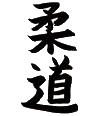


Judo (柔道 ,jūdō?), meaning "gentle way", is a modern Japanese martial art (gendai budō) and combat sport, that originated in Japan in the late nineteenth century. Its most prominent feature is its competitive element, where the object is to either throw one's opponent to the ground, immobilise or otherwise subdue one's opponent with a grappling manoeuvre, or force an opponent to submit by joint locking the elbow or by executing a choke. Strikes and thrusts (by hands and feet) — as well as weapons defences — are a part of judo, but only in pre-arranged forms (kata) and are not allowed in judo competition or free practice (randori).
Judo teaches the principle of flexibility in the application of technique. This is efficient use of balance, leverage, and movement in the performance of Judo throws. Skill, technique and timing, rather than the use of brute strength, are the essential ingredients for success in Judo. For example, in Judo classes you may learn how to give way, rather than use force, to overcome a stronger opponent.
Judo has a strict set of rules that governs competition and ensures safety. For those who want to test their skills, Judo offers the opportunity for competition at all skill levels, from club to national tournaments, to the Olympic Games. Judo is unique in that all age groups, both sexes, and most disabled persons can participate together in learning and practicing the sport. Judo is an inexpensive, year-round activity, that appeals to people from all walks of life. Many people over sixty years of age enjoy the sport, as well as very young boys and girls.
A grading systems allows all students to proceed through levels, or grades, signifying their growth and development. Whilst it is not mandatory for students to go through the grading system, it is a great way for both adults and children to have their progress recognised.
Forms (kata) are pre-arranged patterns of attack and defence, which in judo are practised with a partner at our judo club for the purpose of perfecting judo techniques. More specifically, their purposes include illustrating the basic principles of judo, demonstrating the correct execution of a technique, teaching the philosophical tenets upon which judo is based, allowing for the practice of techniques that are not allowed in competition, and to preserve ancient techniques that are historically important but are no longer used in contemporary judo
Judo emphasises a free-style sparring, called randori, as one of its main forms of training in our judo classes. Part of the combat time is spent sparring standing up, called tachi-waza, and the other part on the ground, called ne-waza. Sparring, even subject to safety rules, is much more practically effective than only practicing techniques on their own, which is what jujutsuka were used to doing. Using full strength develops the muscles and cardio-vascular system on the physical side of things, and it develops strategy and reaction time on the mental side of things, and helps the practitioner learn to use techniques against a resisting opponent. A common saying among judoka is "The best training for judo is judo."
There are several types of sparring exercises in our judo classes, such as ju renshu (both judoka attack in a very gentle way where no resistance is applied); and kakari geiko (only one judoka attacks while the other one relies solely on defensive and evasive techniques, but without the use of sheer strength.)

Judo Calligraphy
Call Sensei Dave Clarke to Join one of our Judo clubs today!
Contact Number: 07956 291064
Email: info@yawaramartialarts.com
Your First class at a Yawara Judo Club is free, so don't hesitate contact us today...
Our Judo clubs are run by professional instructors and focus on junior students. Judo is the ideal sports for children looking to build self-confidence and discipline.